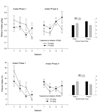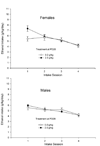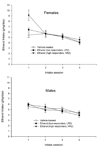High ethanol dose during early adolescence induces locomotor activation and increases subsequent ethanol intake during late adolescence
- PMID: 20373327
- PMCID: PMC3050506
- DOI: 10.1002/dev.20444
High ethanol dose during early adolescence induces locomotor activation and increases subsequent ethanol intake during late adolescence
Abstract
Adolescent initiation of ethanol consumption is associated with subsequent heightened probability of ethanol use disorders. The present study examined the relationship between motivational sensitivity to ethanol initiation in adolescent rats and later ethanol intake. Experiment 1 determined that ethanol induces locomotor activation shortly after administration but not if tested at a later post-administration interval. In Experiment 2, adolescent rats were assessed for ethanol-induced locomotor activation on postnatal Day 28. These animals were then evaluated for ethanol-mediated conditioned taste aversion and underwent a 16-day-long ethanol intake protocol. Ethanol-mediated aversive effects were unrelated to ethanol locomotor stimulation or subsequent ethanol consumption patterns. Ethanol intake during late adolescence was greatest in animals initiated to ethanol earliest at postnatal Day 28. Females that were more sensitive to ethanol's locomotor-activating effects showed a transient increase in ethanol self-administration. Blood ethanol concentrations during initiation were not related to ethanol-induced locomotor activation. Adolescent rats appeared sensitive to the locomotor-stimulatory effects of ethanol. Even brief ethanol exposure during adolescence may promote later ethanol intake.
Figures






Similar articles
-
Prenatal ethanol exposure attenuates sensitivity to the aversive effects of ethanol in adolescence and increases adult preference for a 5% ethanol solution in males, but not females.Alcohol. 2019 Sep;79:59-69. doi: 10.1016/j.alcohol.2018.12.004. Epub 2018 Dec 29. Alcohol. 2019. PMID: 30597200 Free PMC article.
-
Ethanol-induced locomotor activity in adolescent rats and the relationship with ethanol-induced conditioned place preference and conditioned taste aversion.Dev Psychobiol. 2013 May;55(4):429-42. doi: 10.1002/dev.21048. Epub 2012 May 16. Dev Psychobiol. 2013. PMID: 22592597 Free PMC article.
-
Short-term selection for high and low ethanol intake yields differential sensitivity to ethanol's motivational effects and anxiety-like responses in adolescent Wistar rats.Prog Neuropsychopharmacol Biol Psychiatry. 2017 Oct 3;79(Pt B):220-233. doi: 10.1016/j.pnpbp.2017.06.027. Epub 2017 Jun 27. Prog Neuropsychopharmacol Biol Psychiatry. 2017. PMID: 28663116
-
Aversive effects of ethanol in adolescent versus adult rats: potential causes and implication for future drinking.Alcohol Clin Exp Res. 2010 Dec;34(12):2061-9. doi: 10.1111/j.1530-0277.2010.01302.x. Epub 2010 Sep 22. Alcohol Clin Exp Res. 2010. PMID: 20860614 Free PMC article.
-
Heightened ethanol intake in infant and adolescent rats after nursing experiences with an ethanol-intoxicated dam.Alcohol Clin Exp Res. 2004 Jun;28(6):895-905. doi: 10.1097/01.alc.0000128223.95184.c9. Alcohol Clin Exp Res. 2004. PMID: 15201632
Cited by
-
NAAG Peptidase Inhibitors Act via mGluR3: Animal Models of Memory, Alzheimer's, and Ethanol Intoxication.Neurochem Res. 2017 Sep;42(9):2646-2657. doi: 10.1007/s11064-017-2181-4. Epub 2017 Mar 11. Neurochem Res. 2017. PMID: 28285415 Free PMC article.
-
Early maternal separation affects ethanol-induced conditioning in a nor-BNI insensitive manner, but does not alter ethanol-induced locomotor activity.Pharmacol Biochem Behav. 2012 Jan;100(3):630-8. doi: 10.1016/j.pbb.2011.11.005. Epub 2011 Nov 13. Pharmacol Biochem Behav. 2012. PMID: 22108648 Free PMC article.
-
Baclofen alters gustatory discrimination capabilities and induces a conditioned taste aversion (CTA).BMC Res Notes. 2011 Dec 9;4:527. doi: 10.1186/1756-0500-4-527. BMC Res Notes. 2011. PMID: 22152100 Free PMC article.
-
Naloxone blocks ethanol-mediated appetitive conditioning and locomotor activation in adolescent rats.Behav Brain Res. 2011 Jan 1;216(1):262-9. doi: 10.1016/j.bbr.2010.08.005. Epub 2010 Aug 12. Behav Brain Res. 2011. PMID: 20708642 Free PMC article.
-
Adolescent intermittent ethanol exposure induces sex-dependent divergent changes in ethanol drinking and motor activity in adulthood in C57BL/6J mice.J Neurosci Res. 2022 Aug;100(8):1560-1572. doi: 10.1002/jnr.24814. Epub 2021 Mar 16. J Neurosci Res. 2022. PMID: 33725399 Free PMC article.
References
-
- Acevedo MB, Molina JC, Pautassi RM. Ethanol-induced activation in adolescent rats. Paper presented at the 12th Meeting of the Argentinean Association of Behavioral Sciences, Catholic University; August 27–29; Buenos Aires, Argentina. 2009.
-
- Anderson RI, Varlinskaya EI, Spear LP. Isolation stress and ethanol-induced conditioned taste aversion in adolescent and adult male rats. Paper presented at the 41st Annual Meeting of the International Society for Developmental Psychobiology; Nov. 12–15; Washington DC. 2008.
-
- Anthony JC, Petronis KR. Early-onset drug use and risk of later drug problems. Drug and Alcohol Dependence. 1995;40:9–15. - PubMed
-
- Arias C, Mlewski EC, Molina JC, Spear NE. Naloxone and baclofen attenuate ethanol's locomotor-activating effects in preweanling Sprague-Dawley rats. Behavioral Neuroscience. 2009b;123:172–180. - PubMed
Publication types
MeSH terms
Substances
Grants and funding
LinkOut - more resources
Full Text Sources
Medical

